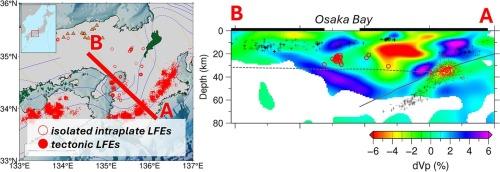Crust and uppermost mantle structure beneath the Kinki district, Japan: Relationship to isolated deep low-frequency earthquakes
IF 2.6
3区 地球科学
Q2 GEOCHEMISTRY & GEOPHYSICS
引用次数: 0
Abstract
Occurrences of deep low-frequency earthquakes are observed in the regions away from volcanoes and the plate boundary in the Kinki district, Japan, and they are referred to as isolated intraplate LFEs. The activation mechanism of these LFEs is not fully understood yet. In this paper, we present the results of travel time tomography around the source areas of the isolated LFEs in the Kinki district. Our velocity model shows two types of velocity features, a low-velocity anomaly beneath the Wakayama earthquake swarm area and a high-velocity anomaly beneath Osaka Bay. Beneath Wakayama area, the low-velocity anomaly extends from the plate boundary to the LFE source area, and the isolated LFEs are located around the boundary of high and low velocity anomaly zones. This result suggests fluid flow from the subducting slab to the earthquake swarm area. In contrast, the uppermost mantle beneath Osaka Bay, where LFEs are also detected, shows a high-velocity anomaly. Our velocity model does not show any signs of fluid pathways from the uppermost mantle to the LFE source area, which were often recognized around volcanic regions in the previous studies. Horizontal fluid influx from surrounding areas or fluid pathways invisible in our model may exist. The high-velocity anomaly zone may represent a cooled melt reservoir formed by past magmatic activity such as Setouchi volcanic activities in the Miocene. Another possible interpretation of the LFE activity beneath Osaka Bay is that ancient magmatic fluids would have remained in the crust, and these fluids could cause the LFEs.

日本近畿地区地壳和上地幔结构:与孤立的深低频地震的关系
在日本近畿地区,在远离火山和板块边界的地区观测到深低频地震的发生,它们被称为孤立的板内生命周期。这些生命周期的激活机制尚不完全清楚。在本文中,我们介绍了在Kinki地区孤立的lfe源区域周围的旅行时间层析成像结果。我们的速度模型显示了两种类型的速度特征,和歌山地震群区下方的低速异常和大阪湾下方的高速异常。在和歌山地区下方,低速异常从板块边界向LFE源区延伸,孤立的LFE分布在高低速异常带和低速异常带边界附近。这一结果表明流体从俯冲板块向地震群区流动。相比之下,大阪湾下的最上层地幔,在那里也检测到生命周期,显示出高速异常。我们的速度模型没有显示出任何从上地幔到LFE源区的流体通道的迹象,这在以前的研究中通常是在火山区域周围发现的。可能存在来自周围区域或模型中不可见的流体路径的水平流体流入。高速异常带可能是由过去的岩浆活动(如中新世濑户内火山活动)形成的冷却熔体储层。大阪湾下生命循环活动的另一种可能解释是,古代岩浆流体可能留在地壳中,这些流体可能导致生命循环。
本文章由计算机程序翻译,如有差异,请以英文原文为准。
求助全文
约1分钟内获得全文
求助全文
来源期刊

Tectonophysics
地学-地球化学与地球物理
CiteScore
4.90
自引率
6.90%
发文量
300
审稿时长
6 months
期刊介绍:
The prime focus of Tectonophysics will be high-impact original research and reviews in the fields of kinematics, structure, composition, and dynamics of the solid arth at all scales. Tectonophysics particularly encourages submission of papers based on the integration of a multitude of geophysical, geological, geochemical, geodynamic, and geotectonic methods
 求助内容:
求助内容: 应助结果提醒方式:
应助结果提醒方式:


